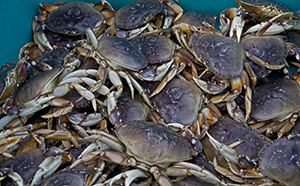Is low oxygen in the ocean near Taholah killing off young crab each year, threatening the future of the fishery?

Source: Northwest Indian Fisheries Commission
That’s the question Quinault Indian Nation (QIN) wants to help answer using special equipment to measure the extent and depth of low oxygen events.
QIN has requested a grant to pay for instruments that would measure dissolved oxygen from inside crab pots. “It’s a great way to get them distributed as part of a fisherman’s normal crab pot routine and they can retrieve them once a month for us so we can download the information,” said Joe Schumacker, marine scientist for QIN.
“Right now, all we know is that dead fish and crab have washed up on our shores in varying degrees in the summer for the past few years” Schumacker said. “We have no idea how far the low oxygen zones extend or how long they last. We see a result and we need to define the problem.” There is also no oral history among Quinault people for consecutive seasons of this sort of die-off.
Dungeness crab is a delicacy served in many fine restaurants and a signature Washington state seafood. Not only has it been important to tribes culturally for millennia, it forms the mainstay of the fishing season for many tribal members on the coast and in Puget Sound.
“Crab has always been a cultural resource for us,” said Ed Johnstone, QIN fisheries and ocean policy representative. “Ever since we have been on these shores, the abundant crab and razor clams sustained us along with the greens of the sea.”
QIN has only one measurement of the oxygen problem from a fish kill in 2006 when a QIN fishermen was pulling his cab pots in a line running north and south. “As he headed north toward Taholah, he was getting live crab in his pots until he crossed the Moclips River. Then it was pot after pot of dead crabs until just past the Quinault River. That’s about eight miles,” said Schumacker. One of the things QIN would like to know is if oxygen-poor water is settling over young crabs who take refuge in nearshore areas. “Maybe we’re losing whole age classes sometimes. We just don’t know,” said Schumacker.
The instruments QIN would use cost $8,500 each including annual maintenance that includes calibration. Six devices would allow QIN to minimally cover the nearshore part of their traditional fishing area. The Nation would also test less expensive dissolved oxygen meters that have traditionally been used in freshwater streams, but would need field testing side-by-side with the more expensive meters to evaluate performance in saltwater and ocean depths.
Low oxygen water naturally upwells from deep in the ocean and gets oxygenated at the surface. “Somehow this mixing isn’t occurring during some summers,” Schumacker said. “These events tend to happen when the winds and the ocean go calm.
“There is a lot of research interest in the low oxygen events along the Pacific Coast, but this affects treaty-protected resources and we need a great deal more information for our area to understand the extent of the problem and how we can adaptively manage around it,” Schumacker said.
